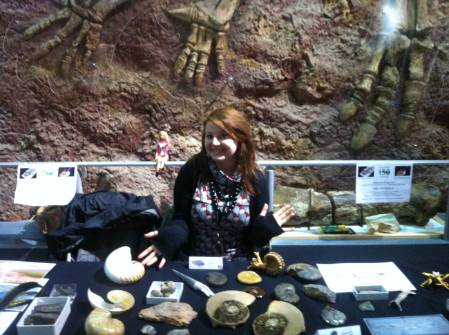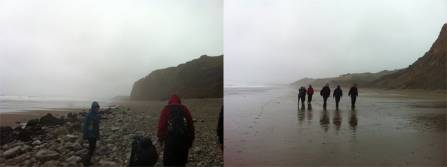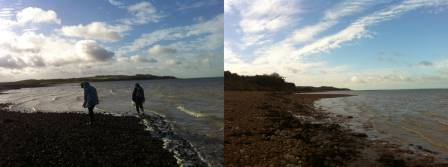Over the weekend as you may have noticed if you follow my Twitter feeds (@NHM_Brachiopoda and @NHM_Cephalopoda) I have been on the Isle of Wight. We arrived on a very wet afternoon on Friday 8 November.
The main reason for our trip was to participate in the Dinosaur Isle Museum's "Blast from the Past" event which gathers local collectors, universities and museums together to talk to the public about palaeontology, fossil collecting and metal detecting.
Me with our display of cephalopods.
Me and my collegues - Dr Martin Munt, Dr Lorna Steel, Dr Christine Stullu-Derrien, Dr Ria Mitchell and Zuzanna Wawrzyniak - had a stall showing the diversity of fossil cephalopods through time and the plant and arthropod fauna of the Rhynie Chert. Lots of people came to talk to us, asking questions about the specimens and bringing their own fossils for us to identify.
On Monday Christine came back to the Museum as she's very busy at the moment but the rest of us stayed on the Isle of Wight to do some fieldwork. We wrapped up warm with lots of layers and waterproofs and braved the weather on Yaverland beach near Sandown. I found some dinosaur ribs and a fish vertebra.
When we went up to Dinosaur Isle that is close by for lunch, we realised our waterproofs had failed and we were all utterly soaked so instead of going back out into the dire weather we were invited to visit the Isle of Wight off-site store to have a look at their collections.
Our group on Yaverland beach getting rather wet and windswept.
Alex Peaker and Martin New of Dinosaur Isle showed us lots of wonderful fossil plants, dinosaurs and invertebrates while Lorna took the opportuinty to have a look at their fossil crocodiles.
On Tuesday the weather was much better and we took a trip to a Pleistocene mammal locality on the east of the island called Saltmead Beach, which is near Newton. Luckily the military firing test zone was not in action that day as we had to cross it in order to get to the beach. After a long walk across a water-logged field and down the beach we finally made it to the site. Lots of bone fragments were found, most likely from bison. These will be passed along to our fossil mammal curator.
Left: Lorna and Zuza looking for Pleistocene bones.
Right: The beach at Saltmead near Newtown.
After lunch we visited an Eocene site known as the insect limestone. Here there were pieces of the limestone strewn on the beach which you can then break open with a hammer. If you are lucky you may find insects such as ants and beetles or even fossil plant remains. In our case, Zuzanna was the lucky one as she found a lovely beetle that our arthropod curator was very excited to recieve for the collection.
Left: Ria breaking up the limestone. Centre: Looking carefully for tiny insects.
Right: The insect limestone.
When we got back to the house Zuzanna started the process of removing the salt from the bison bones we had found. She did this by soaking them in tap water overnight to draw the salt out. In the process, however, a small shore crab emerged from one of the bones! We put it in a tupperware tub (with no lid) with some seaweed from the bone and sea water from the sample bag. In the morning on the way back to the ferry we released him in a suitable pebbly location with seaweed.
Left: The crab we rescued
Right: I'm about to release him!







